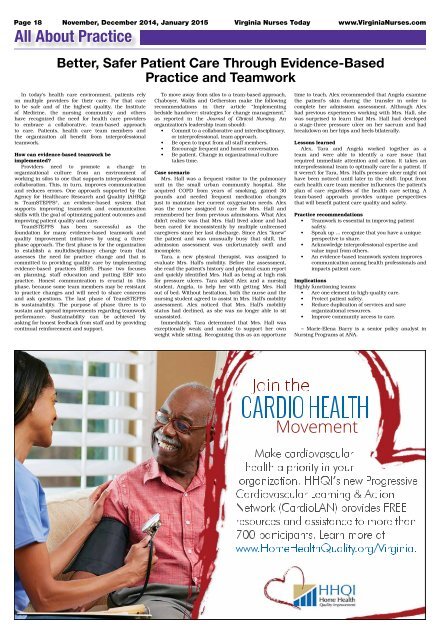Virginia Nurses Today - November 2014
Create successful ePaper yourself
Turn your PDF publications into a flip-book with our unique Google optimized e-Paper software.
Page 18 <strong>November</strong>, December <strong>2014</strong>, January 2015 <strong>Virginia</strong> <strong>Nurses</strong> <strong>Today</strong> www.<strong>Virginia</strong><strong>Nurses</strong>.com<br />
All About Practice<br />
Better, Safer Patient Care Through Evidence-Based<br />
Practice and Teamwork<br />
In today’s health care environment, patients rely<br />
on multiple providers for their care. For that care<br />
to be safe and of the highest quality, the Institute<br />
of Medicine, the nursing community and others<br />
have recognized the need for health care providers<br />
to embrace a collaborative, team-based approach<br />
to care. Patients, health care team members and<br />
the organization all benefit from interprofessional<br />
teamwork.<br />
How can evidence-based teamwork be<br />
implemented?<br />
Providers need to promote a change in<br />
organizational culture from an environment of<br />
working in silos to one that supports interprofessional<br />
collaboration. This, in turn, improves communication<br />
and reduces errors. One approach supported by the<br />
Agency for Healthcare Research and Quality (AHRQ)<br />
is TeamSTEPPS ® , an evidence-based system that<br />
supports improving teamwork and communication<br />
skills with the goal of optimizing patient outcomes and<br />
improving patient quality and care.<br />
TeamSTEPPS has been successful as the<br />
foundation for many evidence-based teamwork and<br />
quality improvement initiatives by using a threephase<br />
approach. The first phase is for the organization<br />
to establish a multidisciplinary change team that<br />
assesses the need for practice change and that is<br />
committed to providing quality care by implementing<br />
evidence-based practices (EBP). Phase two focuses<br />
on planning, staff education and putting EBP into<br />
practice. Honest communication is crucial in this<br />
phase, because some team members may be resistant<br />
to practice changes and will need to share concerns<br />
and ask questions. The last phase of TeamSTEPPS<br />
is sustainability. The purpose of phase three is to<br />
sustain and spread improvements regarding teamwork<br />
performance. Sustainability can be achieved by<br />
asking for honest feedback from staff and by providing<br />
continual reinforcement and support.<br />
To move away from silos to a team-based approach,<br />
Chaboyer, Wallis and Getherston make the following<br />
recommendations in their article “Implementing<br />
bedside handover: strategies for change management,”<br />
as reported in the Journal of Clinical Nursing. An<br />
organization’s leadership team should:<br />
• Commit to a collaborative and interdisciplinary,<br />
or interprofessional, team approach.<br />
• Be open to input from all staff members.<br />
• Encourage frequent and honest conversation.<br />
• Be patient. Change in organizational culture<br />
takes time.<br />
Case scenario<br />
Mrs. Hall was a frequent visitor to the pulmonary<br />
unit in the small urban community hospital. She<br />
acquired COPD from years of smoking, gained 30<br />
pounds and needed frequent medication changes<br />
just to maintain her current oxygenation needs. Alex<br />
was the nurse assigned to care for Mrs. Hall and<br />
remembered her from previous admissions. What Alex<br />
didn’t realize was that Mrs. Hall lived alone and had<br />
been cared for inconsistently by multiple unlicensed<br />
caregivers since her last discharge. Since Alex “knew”<br />
the patient and was unusually busy that shift, the<br />
admission assessment was unfortunately swift and<br />
incomplete.<br />
Tara, a new physical therapist, was assigned to<br />
evaluate Mrs. Hall’s mobility. Before the assessment,<br />
she read the patient’s history and physical exam report<br />
and quickly identified Mrs. Hall as being at high risk<br />
for pressure ulcers. Tara asked Alex and a nursing<br />
student, Angela, to help her with getting Mrs. Hall<br />
out of bed. Without hesitation, both the nurse and the<br />
nursing student agreed to assist in Mrs. Hall’s mobility<br />
assessment. Alex noticed that Mrs. Hall’s mobility<br />
status had declined, as she was no longer able to sit<br />
unassisted.<br />
Immediately, Tara determined that Mrs. Hall was<br />
exceptionally weak and unable to support her own<br />
weight while sitting. Recognizing this as an opportune<br />
time to teach, Alex recommended that Angela examine<br />
the patient’s skin during the transfer in order to<br />
complete her admission assessment. Although Alex<br />
had previous experiences working with Mrs. Hall, she<br />
was surprised to learn that Mrs. Hall had developed<br />
a stage-three pressure ulcer on her sacrum and had<br />
breakdown on her hips and heels bilaterally.<br />
Lessons learned<br />
Alex, Tara and Angela worked together as a<br />
team and were able to identify a care issue that<br />
required immediate attention and action. It takes an<br />
interprofessional team to optimally care for a patient. If<br />
it weren’t for Tara, Mrs. Hall’s pressure ulcer might not<br />
have been noticed until later in the shift. Input from<br />
each health care team member influences the patient’s<br />
plan of care regardless of the health care setting. A<br />
team-based approach provides unique perspectives<br />
that will benefit patient care quality and safety.<br />
Practice recommendations<br />
• Teamwork is essential in improving patient<br />
safety.<br />
• Speak up … recognize that you have a unique<br />
perspective to share.<br />
• Acknowledge interprofessional expertise and<br />
value input from others.<br />
• An evidence-based teamwork system improves<br />
communication among health professionals and<br />
impacts patient care.<br />
Implications<br />
Highly functioning teams:<br />
• Are one element in high-quality care.<br />
• Protect patient safety.<br />
• Reduce duplication of services and save<br />
organizational resources.<br />
• Improve community access to care.<br />
~ Marie-Elena Barry is a senior policy analyst in<br />
Nursing Programs at ANA.

















